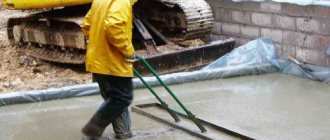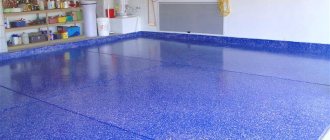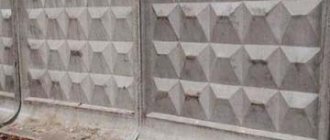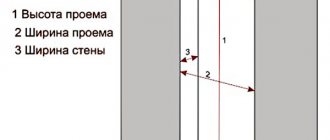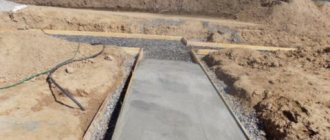Technology and advantages of diamond drilling
Diamond drilling is a technological process that makes it possible to produce cylindrical holes in a wide variety of building materials using diamond tools. Diamond drilling technology allows you to obtain perfectly smooth holes of a given size, depth and shape. This technology can be applied to any building material:
- concrete and reinforced concrete;
- natural stone (granite, marble);
- fake diamond;
- brick;
- ceramics, etc.
You can also drill glass with a diamond tool in non-impact mode.
Diamond drilling (drilling) has become especially relevant after the widespread use of heavily reinforced concrete in construction . If iron can be drilled with a steel drill, and concrete with a hammer drill, then the combination of iron and concrete, which has become synonymous with the highest strength, presents an indefinable barrier to ordinary tools.
The technology of diamond drilling holes in concrete is based on the unique mechanical feature of diamond - its incredible hardness. A tool for drilling holes in concrete has a diamond-coated cutting edge , the so-called “matrix”. Diamond-containing tool segments produce shockless local destruction in the cutting zone during the drilling process. Simultaneously with the destruction of the building material, abrasion of the matrix itself occurs, but thanks to the multi-layering, new diamonds appear on its surface and the working edge constantly remains sharp.
Thanks to the non-impact impact, the destruction of the material occurs only in the area that is in direct contact with the tool. The rest of the surface remains undamaged.
The occurrence of chips and cracks on it is completely excluded. Detachment of concrete from reinforcement also does not occur. Therefore, the strength of the surface in which diamond drilling of concrete occurs remains unchanged. themselves in the concrete are perfectly smooth, even and do not require further processing .
What is also impressive is the speed with which diamond drilling of holes in concrete allows the tool to solve the most complex problems. Depending on the hole diameter and material, the drilling speed can range from 1 to 5 cm per minute .
Advantages of diamond drilling:
- ideal hole surface, requiring virtually no further processing;
- high dimensional accuracy;
- absence of concrete dust;
- drilling of concrete can be done in a horizontal, vertical direction and at an angle;
- the ability to perform work in narrow spaces;
- no noise.
The cost of drilling holes in concrete directly depends on the depth and diameter of the hole, the type of tool used and the surface material. This operation is carried out using special equipment and can be used for a variety of purposes.
Diamond drilling technology for concrete
Concrete is a fairly strong material that is difficult to drill and drill. This is due to the fact that the structure of concrete is far from uniform. Inside the concrete there are inclusions of gravel and crushed stone, which are stronger than many building materials. And once they hit a stone inclusion, traditional drills begin to become dull and in some cases break.
And it’s one thing if you need to drill a shallow hole: there you can quite realistically use tools with classic carbide tips and a tool with the ability to shock loads, called a hammer drill. And it’s a completely different matter if you need to drill a hole of large length and large diameter: in this case, diamond drilling of holes in concrete can come to the rescue.
But you need to understand that even a diamond-tipped drill has great problems coping with the metal reinforcement that is located inside the concrete. Therefore, it is better to drill a hole in such a way as to bypass the reinforcement that is hidden inside the concrete. But if you can’t bypass the reinforcement, then a tool with a diamond cutting edge can also cope with metal reinforcement, although not without problems.
Concrete Diamond Drilling Tool
Diamond is the hardest material that exists in nature. But this does not mean at all that the tool, which is positioned as a diamond one, uses a faceted diamond as a cutting head. Everything is a little simpler. A diamond drill for working on concrete is a special bit in the form of a pipe, the working edges of which are coated with diamond chips. The diamond chips that are sprayed onto the working surface of the tool are of artificial origin, not natural.
The shank of the bit is mounted in the chuck of the electric tool. The diameter of diamond bits can reach 450 mm. And it is rational to use a diamond crown, starting from a 50 mm hole. Up to a diameter of 50 mm, a hole in concrete can be made with a conventional drill with carbide tips.
To ensure normal thermal conditions during concrete drilling, diamond bits for concrete drilling are equipped with a supply for coolant (water).
If you examine diamond sputtering under high magnification, you can see that each element of diamond dust is a crystal with very sharp edges. And it is these edges that perform the function of cutting edges that can fight concrete.
The number of cutting edges is essentially in the six figures. But each of the diamond cutting edges does its own job of cutting concrete.
Diamond bits for drilling concrete can be of two types. The first type is a classic type crown in the form of a pipe. The second type is a diamond crown, in the center of which there is a regular drill. A drill is needed to ensure the necessary alignment of the tool. A tool with a central drill is not always needed, but only in cases where special accuracy of the coordinates of the hole center is needed.
Diamond drilling technology for concrete
Diamond drilling of holes in concrete is mechanically no different from drilling with conventional drills. The rotation of the head is set by an electric tool. The drilling speed depends on the diameter of the head and the depth to which the drilling occurs.
But if in the case of a conventional drill, only two cutting edges are involved in the process of cutting concrete, then in the case of using a diamond-coated head, the number of cutting edges is simply enormous.
When drilling with a diamond-coated head, water is supplied inside the bit, and thus the tool does not overheat and, at the same time, dust is deposited, which inevitably appears during cutting.
Why is cutting tool cooling important?
The diamond chips themselves are not susceptible to high temperatures. Diamond is able to withstand enormous temperatures without deformation or change in its cutting properties. But high temperature affects the connection of diamond dust with the metal of the crown. And in order to reduce chipping of the diamond coating, the cutting part is cooled with water.
Thanks to the tubular design of the crown, the main part of the concrete, in the form of a non-crushed cylindrical part, goes inside the crown structure. If the hole is not through, then the inner part of the concrete is then removed using the pick of a hammer drill. If the hole is through, the resulting cylinder of concrete ends up inside a diamond-coated crown.
Diamond drilling of holes in concrete allows you to get a hole that has the desired diameter without significant deviations in size. This is due to the fact that the crown does not run out during the drilling process, and therefore there are no special deviations in diameter, and most importantly: there are no deviations in the shape of the hole. There is much less dust during drilling with a diamond core bit. And this is due not only to the presence of water in the cutting zone, but also to the fact that the crown makes a narrow cut, and not as when using a drill, cutting occurs along the entire plane of the hole.
Where is diamond drilling for concrete used?
There are several technological problems that are more convenient and rational to solve using diamond drilling of concrete. For example, if you need to lay a large-diameter metal sleeve in a wall for a variety of communications (electrical, water supply, gas, ventilation), then the use of large-diameter diamond-coated crowns is completely justified. If you need a hole in the wall with a diameter of 150 mm - 450 mm, there is simply no alternative to a crown.
You can also use diamond drilling for holes in concrete if you need to make openings in the wall for electrical fittings (sockets, switches). If you need to demolish a thick concrete wall, it sometimes makes sense to drill holes around the perimeter of the demolition. This will make dismantling the wall much easier.
It is only important to select an electric tool based on power for crowns of a certain diameter. The larger the diameter of the crown, the more power the tool should have.
Share:
Scope of drilling with diamond tools
As a rule, diamond drilling equipment is powered by electricity, but manual drilling rigs can now be found on the market.
Diamond drilling is used to create holes:
- in the foundation. Holes in the foundation are sometimes necessary to connect water and electricity supply systems, heating, and sewage systems to city highways;
- in the walls for laying pipes for water supply, heating, sewerage;
- in ceilings for water supply, heating, and sewage riser pipes;
- in ceilings and walls for installation of air conditioning systems;
- in ceilings and walls for ventilation valves and air ducts;
- for installation of chimneys, connection of heating devices;
- for supplying communications to swimming pools;
- for installing internal roof drain risers;
- for installing fencing railings on flights of stairs;
- for installation of automatic fire extinguishing systems.
Diamond drilling of holes in concrete, prices and efficiency largely depend on the equipment used. Diamond drilling can be carried out using rotary hammers or special installations . The latter are used for large volumes of construction work. Directly drilling holes is carried out with diamond drills or crowns.
Where is diamond drilling used?
Construction work, especially on large projects, requires drilling thousands of holes into concrete and other durable materials. Holes are needed for laying communications: cables, water supply and sewerage pipes, ventilation ducts. The use of pneumatic fendering equipment for these purposes has long required increased time and labor costs.
The introduction of diamond drilling technology for holes in concrete has made it possible to increase the productivity of builders while simultaneously reducing work time.
Area of application of diamond drilling:
- laying heating systems;
- installation of sewerage systems and water supply systems;
- holes for riser pipes;
- creating holes in the foundations of buildings for supplying communications;
- installation of fire alarm and automatic fire extinguishing systems;
- creation of openings for vertical and horizontal air ducts in ventilation and air conditioning systems;
- installation of railings, fences and staircases;
- installation of technological equipment of industrial enterprises.
Main characteristics of the drill
An auger is a cutting tool used to drill holes in a wide variety of building materials. A diamond drill for concrete is considered the most reliable and popular tool for drilling holes . Most often, these cutting tools are equipped with hand-held pneumatic and electric hammer drills with an impact energy of up to 35 J. Drills vary in diameter, length, type of fastening and design.
Depending on the fastening, GOST provides several types of drill for concrete. The most widely used are drills with SDS Plus and SDS Max shanks. In everyday life, the SDS Plus concrete drill is most often used. They can be used to drill through or shallow holes of small diameter. For through and deep holes of large diameter, it is recommended to use the SDS Max concrete drill.
The choice of drill depends mainly on the characteristics of the hammer drill used and on the type of material in which the holes will be drilled. When choosing a tool, you must also take into account its diameter and length. A concrete drill for a hammer drill, the price of which can vary significantly depending on the manufacturer, has a special soldering surface, which allows it to easily cope with both reinforced concrete and natural stone.
Modern diamond drilling
Nowadays, diamond drilling has become a very popular method for drilling holes. Today, diamond drilling is used not only in rock drilling, but also in a wide range of construction applications. Workers use diamond drills to drill holes in walls, ceilings and floors. This action is also called “diamond drilling”.
Construction companies really like to use diamond drilling in their work, since this type of drilling does not require additional processing. The hole obtained during drilling turns out to be perfectly smooth, even in very thick and dense building materials. Diamond drilling is used for laying new pipelines (gas, water, sewerage) and many other needs.
Types of diamond drill bits for hammer drills
The cheaper the drill, the less durability and performance you can expect from it
All drills are divided into the following types:
- screw - self-sharpening. These drills have a design that allows you to very quickly remove sludge from the cutting area. They are mainly produced with an SDS Plus shank and are used for installation and repair of not very heavy building structures;
- spiral. They usually have a large diameter. A spiral drill for a concrete hammer drill, the dimensions of which allow deep holes to be made, is used when installing air conditioners or dismantling not very thick walls;
- flat. With the help of such drills, holes of small depth are made. Their advantage is that they have a longer service life than spiral ones.
Drills are used for different purposes, differing in design, quality and price. Based on cost, all drills can be divided into three categories.
Drill price categories:
- the most inexpensive drills. These drills are only suitable for one-time use. Sometimes they are not even marked;
- drills for home use, produced by reputable companies. Such a tool is more expensive compared to consumer goods, but it will last longer, for example, concrete drills for a rotary hammer, Hilti sizes;
- drills for professional equipment. Such drills are considered the most expensive, but they are of the highest quality. Therefore, if finances allow, then it is better to buy just such a diamond drill for concrete.
For home use, you can buy a concrete drill for a hammer drill, which belongs to the middle price category (Stayer, Matrix, Bergen, Zubr). When choosing a drill, remember that it is a consumable item and cannot be repaired . Therefore, you should not buy a concrete drill made by someone unknown, the price of which is very low. Such a drill can break the hammer drill chuck so much that even a very good tool in it will break.
Diamond drilling rig
All actions are performed using a special drilling installation. The installation itself consists of an engine, a frame, and the drill bit itself.
The drill bit looks exactly like a hollow pipe with a certain diameter. It also contains a special device that is required to attach the shaft to the engine and the diamond segments themselves. Units with an electric motor, usually from 2.3 to 5.5 kW, require a water supply to cool the bit during the drilling process itself. A spacer anchor is used to mount the machine to the wall. By the way, water, in addition to cooling the bit itself, is also responsible for removing waste from the working area of the installation and the integrity of the segments during the drilling process. Used water, usually from 1 to 15 liters per hole, is collected in a special container. Rarely, a water vacuum cleaner is still required, but this depends on the specific conditions at the construction site.
A little history
The era of diamond drilling began a long time ago, in 1863, when they tried to build a railway tunnel in the Alps. The workers had at their disposal the most advanced technologies of the time, such as a steam drilling machine and other types of drills. The person in charge of all this was Loshe, who was a good technical specialist. But these drills were not suitable for the mountains of the Alps, which contained huge amounts of hard rock. At that time, Losche spent a long time looking for a way to solve this problem. And he managed to find it. He is considered the inventor of diamond drilling. At that time, the Losche diamond bit was considered an innovation and worked perfectly. Thus, it was Losche who is considered the man who began the era of diamond drilling. Although the design of the first samples was not ideal, diamonds very often crumbled and fell out of their recesses. Nowadays this device is perfect.
Tools for drilling large diameter holes
To create cylindrical holes of large diameter, a special type of drill is used - crowns . The body of the drill bit has the shape of a hollow pipe. At one end of the housing there is a special mechanism for attaching the crown to the motor shaft, and at the other, diamond-containing segments are soldered. A drill with a small screw thread acts as a core. Its length is 1-2 cm greater than the height of the body. The core is used to center the hole being made.
Drilling concrete with a crown, the price of which is considered one of the disadvantages of this method, is performed using a heavy hammer drill or a special installation. The diameter of the crown can reach 1000 mm , and upon request it can be increased even more. In this case, the drilling depth is limited by the height of the housing.
Why “diamond” drilling
Diamond means “hardest” in Arabic. There is a Mohs hardness scale, and there the mineral received 10 points out of 10. Since natural diamond is very expensive, its use could not become widespread outside the jewelry industry until the middle of the 20th century, when synthetic diamonds became available. They are not of interest to jewelers, but have retained their strength characteristics and are used in a wide range of production processes, including drilling (drilling cylindrical holes).
More than a thousand types of diamond tools are produced in Russia alone. Diamond drilling tools are, of course, not made of diamonds, but their equipment is crowns, drills have diamond-containing segments. And although diamond has a very low coefficient of friction, it still wears out during the drilling process, but the cutting edge - the “matrix” always (until the resource is exhausted) remains sharp, since it is multi-layered. As the edge wears away, a new layer of diamond chips appears, which determines the quality of diamond drilling. Material destruction occurs only in the cutting zone. This effect cannot be achieved by any of the construction tools.
This is interesting: The first experiment with diamond drilling was carried out by Georg Lescho. A Swiss engineer produced the first diamond bit, which was successfully tested while drilling a tunnel in the Alps in 1882. Due to the high cost of crowns with natural diamonds, the invention remained just history for a long time.
Diamond drilling price
The price of diamond drilling should also include depreciation of tools and equipment, as well as energy consumption
The price of drilling holes with diamond tools is influenced by the following factors:
- complexity of the work (drilling a wall in a hard-to-reach place or at an angle);
- type of building material for the supporting structure of the building;
- diameter, depth and number of holes made.
Diamond drilling of holes in concrete, price:
| Hole diameter, mm | Brick, foam concrete, aerated concrete | Reinforced concrete, monolith |
| 40 — 70 | 15 rub/cm | 22 rub/cm |
| 80 — 100 | 17 rub/cm | 24 rub/cm |
| 200 | 30 rub/cm | 37 RUR/cm |
| 300 | 45 rub/cm | 60 rub/cm |
Diamond drilling of holes in concrete is shown in the video:
Advantages of diamond drilling
Despite the high cost of diamond drilling equipment, this technology provides a number of advantages.
- You can drill holes in horizontal, vertical and inclined planes, as well as in limited space;
- High drilling speed (up to 6 cm/min);
- Wide range of diameters of drilled holes and their precision;
- Great drilling depth (up to 3 meters);
- Smooth openings and openings;
- Low vibration level;
- Absolute safety of the work performed for load-bearing structures;
- No debris or dust;
- Drilling holes in concrete is carried out without impact loads, which completely eliminates the possibility of defects appearing on the treated surface;
- A powerful motor makes it possible to drill a hole in almost any solid material (reinforced concrete, brick, rubble stone, granite, marble, etc.) in a matter of minutes;
- Rigid fastening on the surface being processed relieves the operator of unnecessary effort to hold the tool in a given position.
Thanks to diamond drilling technology, punching a hole of any diameter and depth in materials of increased hardness has become much easier and faster. The compact equipment operates almost silently. Diamond drilling is the best solution when carrying out various types of repair and construction work.


